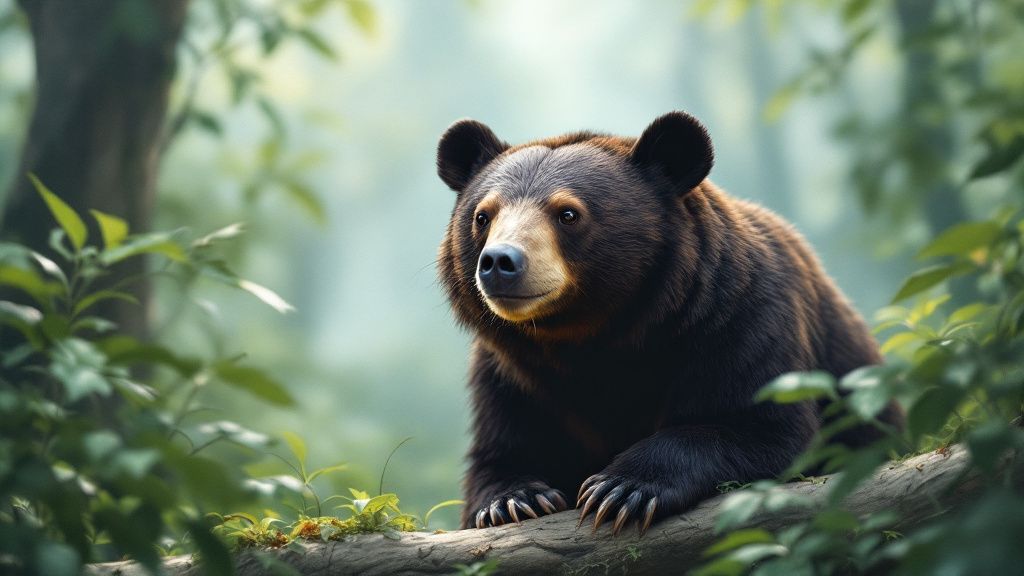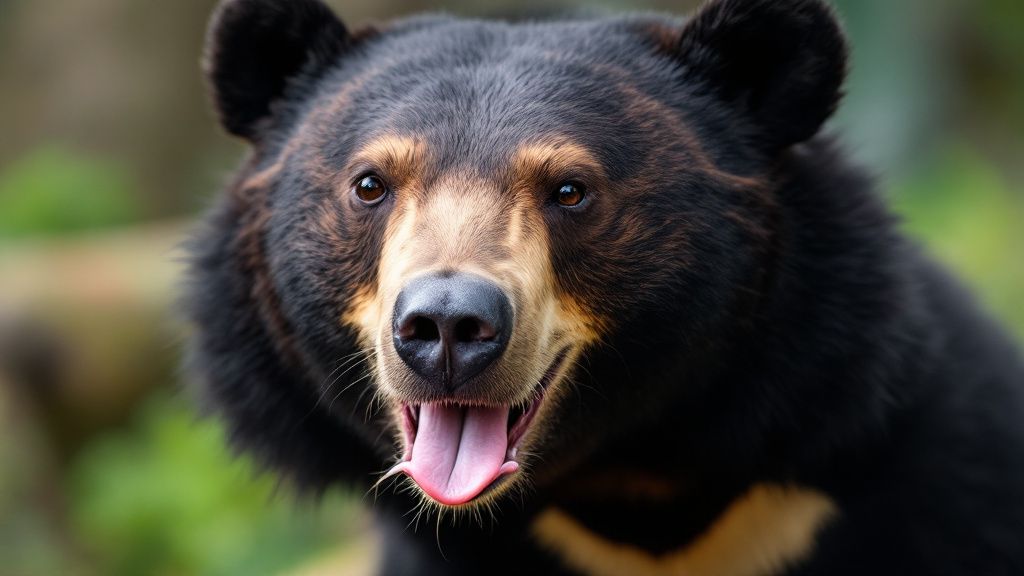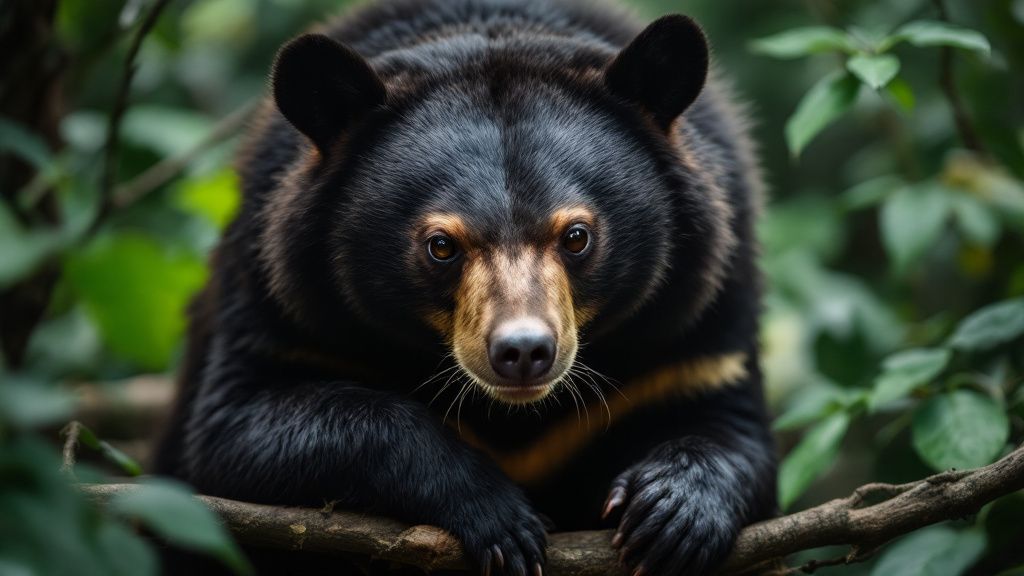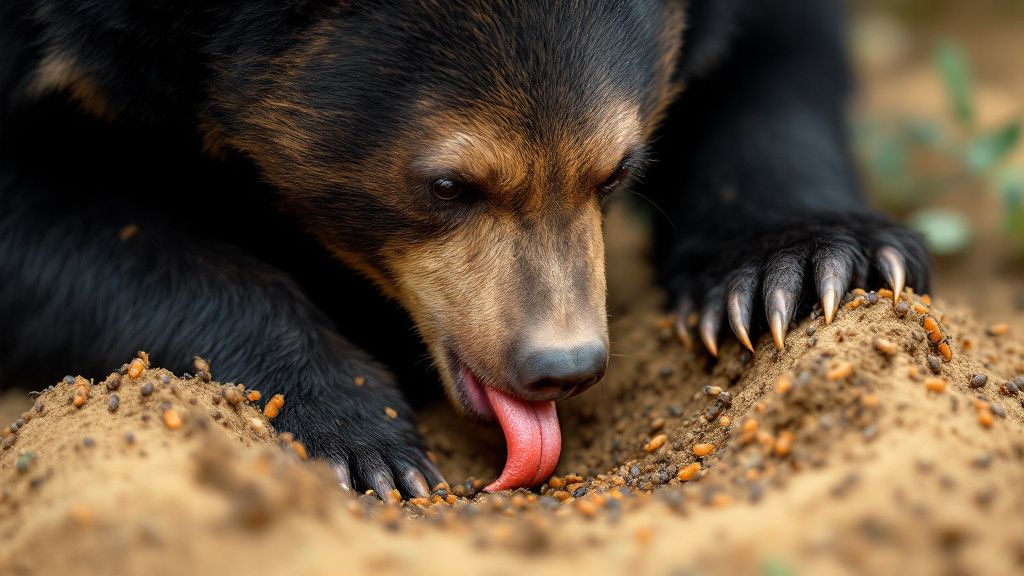
Sun bears are among the most unique and unusual animals in the world, offering a captivating glimpse into the diverse tapestry of Earth's wildlife. These remarkable creatures, native to the tropical forests of Southeast Asia, are known for their distinct features and behaviors that set them apart from other bears. Smallest of the bear family, sun bears have an unmistakable appearance, with a sleek black coat and a vibrant, horseshoe-shaped patch of orange or gold on their chests, giving them their name as they resemble the rising or setting sun.
These bears possess some unique adaptations for survival. Their long tongues, which can extend up to 20 to 25 centimeters, are perfect for extracting honey from beehives, earning them the nickname "honey bears." In the wild, sun bears are primarily solitary creatures, demonstrating unusual animal behavior compared to their larger bear relatives that often display more social tendencies. Despite their size, they are powerful climbers, using their strong, curved claws and paw pads to navigate the forest canopy in search of food. This adaptation is crucial for accessing food sources such as fruits, insects, and small vertebrates, exhibiting a fascinating element of their survival strategy.
As one explores the animal discovery journey into the world of sun bears, it becomes apparent that, like many rare animals, they face several conservation challenges. They are classified as an endangered species due to habitat destruction, illegal wildlife trade, and poaching, primarily for their gallbladders and paws. The loss of their natural habitat to logging and agricultural expansion further exacerbates the threats to their survival. It's vital that animal rights organizations work alongside local communities to promote animal conservation efforts, ensuring the continued existence of sun bears in their natural habitats.
The allure of exotic pets has sometimes made sun bears the target of illegal pet trade, where individuals seek to buy exotic animals, including uncommon pets for private collections. This trade poses significant ethical and practical challenges, as sun bears are wild animals with specific habitat and dietary requirements that cannot be met in captivity. Responsible and informed wildlife experiences, such as those offered by sustainable ecotourism initiatives like those at your local wildlife sanctuary or nature reserve, provide alternative opportunities for appreciating these fascinating creatures without compromising their welfare.
As you immerse yourself in the extraordinary world of unique animal facts, it's important to recognize the role each creature plays in maintaining the delicate balance of our planet's ecosystems. Sun bears, with their unique wildlife presence, not only captivate our imaginations but also highlight the need for collaborative conservation efforts. By supporting and promoting animal conservation programs, you contribute to the preservation of these weird animal species and their vital habitats, ensuring future generations can experience the wonder of sun bears and other unusual animals in the wild.

Exploring the distinctive characteristics of sun bears unveils the many layers of their fascinating nature and physical attributes. As you delve into the realm of these strange animals, you will uncover the traits that make them an intriguing subject of study and animal conservation focus.
Sun bears are the smallest members of the bear family, typically weighing between 60 to 145 pounds and standing about 50 inches tall when fully grown. Despite their petite size, they are incredibly strong, possessing powerful limbs and muscular shoulders that aid in their arboreal lifestyle. This compact build supports their notable climbing abilities, allowing them to maneuver through the dense underbrush and scale trees with agility and grace. As unusual animals, sun bears exhibit a sleek, black coat that is shorter than those of other bears, helping them withstand the hot, humid climate of their tropical rainforest habitat.
A defining feature of these unique animals is their exceptional dental structure. Sun bears have wide jaws and high canine teeth, which they use effectively for tearing open tree bark and consuming diverse foods. Their omnivorous diet mainly consists of fruits, berries, roots, and insects, complemented by the occasional small vertebrate. This diverse palate underscores their adaptability to their environment, an essential trait for survival in rapidly changing habitats.
In addition to physical characteristics, sun bears possess behaviors that pique curiosity. Their solitary nature stands out among bear species, engaging minimally with others except during mating seasons or when a mother is rearing her cubs. This lack of social interaction is a unique behavior, offering insights into their ecological roles and mating habits within their natural ecosystems.
Understanding these remarkable aspects of sun bears is crucial for animal rights organizations and exotic pet enthusiasts seeking to promote ethical wildlife interactions. For individuals desiring a more profound connection with nature, experiences at wildlife sanctuaries or educational tours offered by conservation-focused enterprises can provide valuable insights into the world of sun bears without compromising their welfare. In a world where the concept of exotic pets often translates into challenges, choosing to support businesses that prioritize animal well-being over private ownership helps in preserving these rarities for future generations. By participating in and promoting such initiatives, you contribute to a broader effort to conserve and understand the unique animal adaptations of these captivating creatures.

Conservation efforts for sun bears, as shared by experts in the field, reflect the urgency and dedication required to protect these rare animals from escalating threats. Comprehending the intricacies of sun bear conservation involves appreciating the collaborative endeavors and strategic approaches utilized to ensure their survival.
The sun bears' classification as endangered species highlights their vulnerability, driven by habitat loss due to deforestation and human encroachment. A primary factor affecting their population is illegal poaching, fueled by the demand for exotic pets and traditional medicine. Expert insights suggest that establishing protected areas and enhancing wildlife corridors are vital measures for preserving sun bears’ natural habitats, allowing these uncommon pets to thrive without human interference.
Leading animal conservation programs emphasize the critical role of education and local community engagement. By fostering awareness and sustainable practices among those living near sun bear habitats, conservationists aim to reduce human-wildlife conflict and mitigate illegal trading practices. This educational strategy is reinforced by partnerships with animal rights organizations dedicated to protecting unique wildlife, ensuring that conservation messages reach a global audience.
Technological advancements play a significant role in sun bear conservation. Experts use satellite imagery and GPS tracking to monitor sun bear movements and assess habitat changes. Data collected through these methods inform conservation strategies and aid in the development of targeted protection plans. This scientific approach, combined with traditional conservation efforts, enhances the prospects for the sun bear's future, offering a comprehensive view of their adaptation to environmental shifts.
For enthusiasts and ecological advocates keen on contributing to these efforts, supporting businesses and projects centered on biodiversity and conservation, such as local wildlife sanctuaries or eco-tourism initiatives, is an excellent start. By visiting these destinations or participating in conservation-focused programs, you can gain deeper insight into unique animal facts and engage ethically with nature.
Ultimately, expert insights reveal that a blend of science, community, and commerce can collectively foster a sustainable framework for preserving sun bears and promoting animal conservation. By rallying around this cause, you help safeguard the future of these weird animal species while sustaining the ecological harmony they represent.

Conserving sun bears presents numerous challenges, underscoring the complexities faced by those working to protect these unique animals. The myriad issues confronting conservation efforts demand innovative solutions and broad-based support from various stakeholders, including local communities, governments, and international organizations.
One of the most pressing challenges is habitat destruction. Deforestation, driven by agricultural expansion and logging activities, poses a significant threat to sun bear populations as it results in the loss of critical forest areas where they forage and roam. This habitat fragmentation not only reduces the available living space for these animals but also disrupts their natural behaviors, leading to increased human-wildlife conflicts. Such interactions often result in sun bears venturing into human settlements in search of food, further heightening their vulnerability.
The illegal wildlife trade compounds the difficulty of sun bear conservation. As sun bears are sometimes sought after as exotic pets or for their body parts, they face the constant threat of poaching. The trade not only depletes wild populations but also highlights the need for stricter enforcement of wildlife protection laws. Addressing this issue requires enhanced collaboration between international animal rights organizations and local law enforcement agencies to dismantle trafficking networks and prosecute offenders effectively.
Limited public awareness about sun bears and their ecological importance is another hurdle. Many people remain unaware of the role these uncommon pets play in their ecosystems, such as their contributions to seed dispersal and pest control. Increasing public understanding through educational campaigns, workshops, and community outreach is vital to fostering support for conservation initiatives.
Financial constraints also impede efforts to safeguard sun bears. Conservation projects often rely heavily on funding from governmental and non-governmental sources, which can be unpredictable and insufficient. Sustainable funding models, including partnerships with conservation-minded businesses and eco-tourism ventures, provide potential avenues for securing the necessary resources. Engaging with enterprises that prioritize environmental responsibility can boost funding while promoting awareness of unique wildlife conservation.
Despite these challenges, optimistic progress is evident as more stakeholders join the fight to protect sun bears. By supporting businesses and initiatives committed to preserving biodiversity and supporting animal conservation, you can play a crucial role in overcoming the hurdles that impede the survival of these strange animals. Through collective effort, a more stable future can be secured for the incomparably unique sun bear and the ecosystems they inhabit.

Looking ahead, the future of sun bear conservation is shaped by emerging trends that promise to enhance protection efforts for these rare animals. As new strategies are developed and existing practices are refined, there is a growing emphasis on collaborative, sustainable approaches that align with broader ecological goals.
A notable trend in conservation is the integration of cutting-edge technology. Innovations such as drone surveillance, remote sensing, and AI-powered analytics are increasingly being employed to monitor sun bear populations and habitats accurately. These tools provide conservationists with real-time data, enabling them to track habitat changes, poaching threats, and behavioral patterns more efficiently. This technology-driven approach facilitates informed decision-making and targeted intervention, enhancing the effectiveness of conservation programs.
Community involvement continues to be crucial in shaping the future of sun bear conservation. As local populations become more engaged in protecting their natural resources, there is a shift towards community-led conservation initiatives. These programs empower residents to take active roles in safeguarding their environment, fostering a sense of ownership, and ensuring that conservation efforts are culturally sensitive and sustainable. By merging traditional knowledge with scientific research, communities can implement context-specific solutions that benefit both sun bears and local people.
The rise of eco-tourism presents another promising avenue for future conservation. Sustainable travel initiatives not only generate vital funding for conservation projects but also raise awareness among travelers about the importance of preserving unique wildlife. By promoting responsibly managed ecotourism ventures, businesses involved in this sector can contribute directly to conservation while offering informative and engaging experiences for visitors. For example, organizing educational tours focused on animal discovery and unusual animal behavior can provide tourists with an understanding of sun bears' role in their ecosystems, encouraging more people to support conservation efforts.
Conservation partnerships between governments, NGOs, and the private sector are becoming increasingly important. These alliances pool resources, expertise, and influence to create comprehensive action plans aimed at long-term sustainability. By fostering cooperation across various levels and sectors, these partnerships ensure that sun bear conservation receives the necessary support and attention.
As you consider your impact on wildlife conservation, supporting enterprises and initiatives that prioritize ethical interactions with nature can have far-reaching benefits. Whether through sustainable business practices, responsible eco-tourism, or active involvement in community programs, your contribution can amplify the collective efforts to secure a thriving future for sun bears and their habitats within our rapidly changing world.

Sun bears exhibit a range of fascinating and unique behaviors that make them stand apart in the animal kingdom. As you delve into animal discovery, you'll uncover the intricate details of how sun bears interact with their environment, showcasing behaviors that are both intriguing and vital for their survival.
One such unique behavior is their arboreal lifestyle. Sun bears are avid climbers, spending considerable time in the forest canopy. This adaptation allows them to forage effectively for fruits, honey, and insects, which form the core of their diet. Their strong, curved claws and flexible paw pads enable them to navigate tree branches with ease, highlighting their distinctive adaptation among bear species.
Communication among sun bears is both subtle and sophisticated. They primarily rely on scent marking and vocalizations to convey messages. Scent marking involves using their scent glands to leave distinct chemical signals on trees and other surfaces, warning other bears of their presence or marking territory. These weird animal species often use vocalizations like growls or roars during mating or when they feel threatened, further illustrating their complex communication methods.
Sun bears also demonstrate unusual problem-solving abilities. Known for their ingenuity, they use tools like sticks to extract insects from their hiding places or to access honey, showcasing a remarkable level of intelligence. Observing such behaviors in the wild offers unique animal facts that deepen our understanding of their cognitive capabilities and adaptability.
Their solitary nature is another behavior that sets sun bears apart. Unlike many other bear species that may exhibit family groupings or social interactions, sun bears tend to lead solitary lives, only coming together for mating or when a mother is raising her cubs. This tendency underscores their role as independent foragers and dispersers of seeds within their ecosystems, further emphasizing their ecological importance.
For those passionate about observing sun bears and supporting their conservation, engaging with eco-tourism ventures that prioritize ethical wildlife interactions is a valuable way to appreciate these behaviors firsthand. By choosing wildlife experiences that respect animal welfare and promote educational insights, such as guided tours at reputable wildlife sanctuaries, you not only gain deeper appreciation but also contribute to efforts aimed at preserving these fascinating creatures for future generations. This ethical engagement ensures that sun bears can continue to display their unique characteristics within their natural habitats, unimpeded by human threats.

Understanding sun bear population statistics provides crucial insights into their current conservation status and the challenges they face in the wild. As with many endangered species, accurately estimating sun bear populations is complex due to their elusive nature and the dense, remote habitats they occupy.
Sun bears are primarily found in Southeast Asia, with populations spread across countries like Malaysia, Indonesia, and Thailand. However, exact numbers are difficult to pinpoint, as these regions are characterized by vast, forested areas and limited accessibility, which hampers comprehensive surveys. Despite these challenges, wildlife experts estimate that sun bear numbers are declining at an alarming rate, primarily due to habitat destruction and poaching.
Deforestation for agriculture and logging is a significant factor reducing their habitable zones, fragmenting their populations, and making them even harder to count. As their forest homes are converted into palm oil plantations or cleared for timber, sun bears are left with fewer resources and shrinking territories, contributing to their status as a vulnerable species.
In regions where reliable data is collected, the statistics paint a concerning picture of decline. Studies indicate that in many areas, sun bear populations have decreased by over 30% in recent decades. This trend underscores the urgent need for increased conservation efforts and cross-border cooperation among countries sharing sun bear habitats.
Animal rights organizations are working tirelessly to address these disturbing trends, with initiatives focusing on habitat protection, anti-poaching efforts, and community education. With the aid of conservation technology, experts continue to refine population estimates, employing methods like camera traps and genetic analysis to gather accurate data and identify critical habitats in need of protection.
For individuals who want to contribute to the survival of these rare animals, supporting conservation programs and businesses that prioritize sustainable practices is crucial. By advocating for and participating in conservation efforts, you can play a role in reversing these declining statistics, helping to ensure that sun bears continue to be a vibrant part of our planet's unique wildlife tapestry. Through collective action, there’s hope for stabilizing and potentially increasing sun bear populations, ensuring their ecological roles remain intact for future generations to appreciate and study.
Get free resources, early access to new features and updates.
No spam. Just fun educational emails!